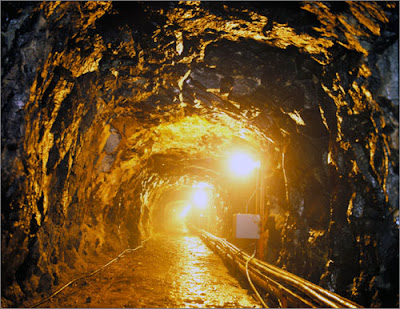At Paju, Panny and I were able to go into the third tunnel. This “work of art” was allegedly built by the North Koreans to gain a secret access and gateway into South Korea, one of many that have been found.
You can wear what you like, as long as you have a blue hard hat on, but all possessions you have must be placed in a locker before heading down into the tunnel. You cannot take a camera or photos inside the Third Tunnel, so all the photos here are either my photos from outside or ones I found online from inside.
It’s actually way more touristy than it is scarey believe it or not, and it didn’t feel at all creepy going down into the tunnel. A monument, the one above marks the walkway up to the tunnel entrance.
Panny and I with our hard hats on.
We sat side by side on a slow monorail, that edges you down deep under the ground into the end part of the third tunnel. Entrance above, and last legal photo before I locked up my camera. The tunnel ends at the base where you get off the monorail, because that’s when the South Korean’s discovered it, therefore the North Korean retreated.
It has been dug out using dynamite, and has now been sealed off and cordoned off. Once you get into the tunnel, you can see the vast size of it, people can walk side by side in it. It brought back reminders of the mining tour I did in Potosi, Bolivia, however here, it was breathable and not as daunting. A bizarre feeling really.
We walked in single file along to where the tunnel ends, or has been sealed off – beyond this point you’re heading into the unknown – North Korea. When you get to the end, you can stare blankly through a deliberate spy hole into North Korea. It’s a wee bit eerie, knowing there could be someone on the other side, even a sniper or with dynamite or guns. You’re really not sure how safe it is. But you walk in line, take a look and walk back. Nothing more to it. At that point we are probably 20 metres or so south of North Korea itself, though it’s all still within the DMZ, so in theory there shouldn’t be any weapons or risk here…
There’s a fresh water tap in the third tunnel, which you can drink from, probably there more for tourists and anyone who suffers from claustrophobia or fear of being trapped underground.
Once all that was done, and we read the few information boards inside the third tunnel (which felt like an underground bunker), it was back onto the monorail and back out into civilisation at Paju. There are 4 tunnels as you can see, officially the tunnel is known as The Third Tunnel of Agression.
Panny in her pink hat, and the lockers before going into the Third Tunnel.
Panny sporting her hard hat.
Me sporting my hard hat. It may not look it – but it was a cold day!
With my hard hat and the rest of the hard hats behind me. I needed the hat – was tight in the tunnel and bumped my head a lot of times.
Flying my Northern Ireland flag at the visitor entrance to the Third Tunnel.
The Third Tunnel is also randomly the third part of my DMZ trip report, after the tunnel and Paju, it was off to Dorasan Station!
Nationalities Met – South Korean
Countries Seen – South Korea, North Korea
Depth of Tunnel – 73 metres below the ground (at deepest part)
Width and Height of Tunnel – 2 metres by 2 metres
Length of Tunnel – 1.7 kilometres
Transport Used – Monorail
Key Song –
DIRE STRAITS – TUNNEL OF LOVE:
A Video I Took Just Before Going Into the Third Tunnel:
Here’s some information on The Third Tunnel (named because it was the third one the South Koreans found):
Only 44 km (27 miles) from Seoul, the tunnel was discovered in October 1978 based on information provided by a defector.It is 1.7 km (1.1 miles) long, 2 m (6.6 ft) high and 2 m (6.6 ft) wide.It runs through bedrock at a depth of about 73 m (240 ft) below ground. It is apparently designed for a surprise attack on Seoul from North Korea, and can easily accommodate 30,000 men per hour along with light weaponry. Upon discovery of the third tunnel, the United Nations Command accused North Korea of threatening the 1953 armistice agreement signed at the end of the Korean War.Its description as a “tunnel of aggression” was given by the South, who considered it an act of aggression on the part of the North.
A total of four tunnels have been discovered so far, but there are believed to be up to twenty more.South Korean and U.S. soldiers regularly drill in the Korean Demilitarized Zone in hopes of finding more.
Initially, North Korea denied building the tunnel.However, observed drill marks for dynamite in the walls point towards South Korea and the tunnel is inclined so that water drains back towards the northern side of the DMZ (and thus out of the way of continued excavation).
North Korea then officially declared it part of a coal mine; black “coal” was painted on the walls by retreating soldiers to help confirm this statement. However, statements in the tunnel claim that there is no geological likelihood of coal being in the area. The walls of the tunnel where tourists are taken are observably granite, a stone of igneous origin, whereas coal would be found in stone of sedimentary origin.
Photos are forbidden within the tunnel, which is now well guarded, though it is a busy tourist site, where visitors enter by going down a long steep incline that starts in a lobby with a gift shop. The South Koreans have blocked the actual Military Demarcation Line in the tunnel with three concrete barricades. The third is visible by tourists visiting the tunnel and the second is visible through a window in the third.


